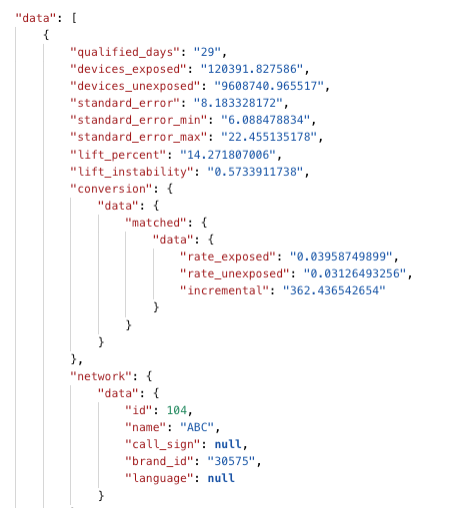Currently, iSpot offers 5 different way to pull Lift data by. See below for Lift API calls aggregated by the endpoint.
Important filters needed to pull Lift
Replace TC-XXXX-X with your client's id. Reach out to your CS rep to confirm id
Lift calls can be filtered by conversion type and app. to find the full list of available conversion types, click here.
Lift Overall
https://api.ispot.tv/v4/metrics/conversions/TC-XXXX-X/lift/summary?page[size]=1000&filter[start_date]=2020-10-20&filter[end_date]=2020-10-20&filter[conversion_attribution_window]=7d&filter[use_attribution_window]=1&filter[conversion_type]=VISIT&filter[conversion_application]=WEB&filter[min_qualified_days]=0
Lift by Network
https://api.ispot.tv/v4/metrics/conversions/TC-XXXX-X/lift/networks?page[size]=1000&filter[start_date]=2020-10-20&filter[end_date]=2020-10-20&filter[conversion_attribution_window]=7d&filter[use_attribution_window]=1&filter[conversion_type]=VISIT&filter[conversion_application]=WEB&filter[min_qualified_days]=0
Lift by Network Family
https://api.ispot.tv/v4/metrics/conversions/TC-XXXX-X/lift/networkfamilies?page[size]=1000&filter[start_date]=2020-10-20&filter[end_date]=2020-10-20&filter[conversion_attribution_window]=7d&filter[use_attribution_window]=1&filter[conversion_type]=VISIT&filter[conversion_application]=WEB&filter[min_qualified_days]=0
Lift by Daypart
https://api.ispot.tv/v4/metrics/conversions/TC-XXXX-X/lift/day-parts?page[size]=1000&filter[start_date]=2020-10-20&filter[end_date]=2020-10-20&filter[conversion_attribution_window]=7d&filter[use_attribution_window]=1&filter[conversion_type]=VISIT&filter[conversion_application]=WEB&filter[min_qualified_days]=0
Lift by Spot
https://api.ispot.tv/v4/metrics/conversions/TC-XXXX-X/lift/spots?page[size]=1000&filter[start_date]=2020-10-20&filter[end_date]=2020-10-20&filter[conversion_attribution_window]=7d&filter[use_attribution_window]=1&filter[conversion_type]=VISIT&filter[conversion_application]=WEB&filter[min_qualified_days]=0
Also note, the API calls above will match the iSpot Lift dashboard which is useful for QA purposes. The Lift API endpoint also supports additional filters that can return data that may not appear in the dashboard. These values are tied to the intercept and exposed parts of the lift model.
Intercept contains the negative lift. Exposed contains the standard lift.
Sample Lift Metrics. Example below is for Network.

Additional filters
filter[lift_mask_min]=integer (-10 to 1000)
filter[min_qualified_days]=number
filter[lift_instability_max]= number
filter[model_param]=exposed or intercept.
What is the meaning of these lift_instability filters?
- It a simplified representation of error bars.
Is there any reason to change the min bound?
- It is a way to control confidence. So really it’s up to the user to determine how they’d like the data.
What are the default values? Is it possible that we will miss any results with these filters that we would normally get without them?
- min_qualified_days=2
lift_instability_max=2.0
lift_mask_min=0
Is there a way to full the lift by day and endpoint?
Yes there is. Add /details to the endpoint ex. network/details to get data broke out by day and model parameter type.